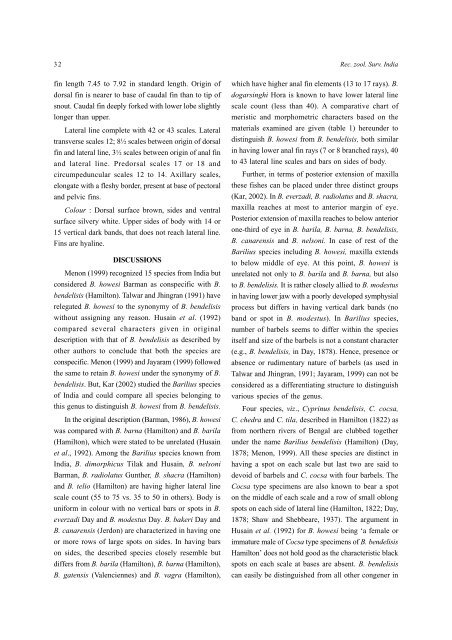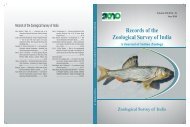Vol. 111 - Part I - Zoological Survey of India
Vol. 111 - Part I - Zoological Survey of India
Vol. 111 - Part I - Zoological Survey of India
Create successful ePaper yourself
Turn your PDF publications into a flip-book with our unique Google optimized e-Paper software.
32 Rec. zool. Surv. <strong>India</strong><br />
fin length 7.45 to 7.92 in standard length. Origin <strong>of</strong><br />
dorsal fin is nearer to base <strong>of</strong> caudal fin than to tip <strong>of</strong><br />
snout. Caudal fin deeply forked with lower lobe slightly<br />
longer than upper.<br />
Lateral line complete with 42 or 43 scales. Lateral<br />
transverse scales 12; 8½ scales between origin <strong>of</strong> dorsal<br />
fin and lateral line, 3½ scales between origin <strong>of</strong> anal fin<br />
and lateral line. Predorsal scales 17 or 18 and<br />
circumpeduncular scales 12 to 14. Axillary scales,<br />
elongate with a fleshy border, present at base <strong>of</strong> pectoral<br />
and pelvic fins.<br />
Colour : Dorsal surface brown, sides and ventral<br />
surface silvery white. Upper sides <strong>of</strong> body with 14 or<br />
15 vertical dark bands, that does not reach lateral line.<br />
Fins are hyaline.<br />
DISCUSSIONS<br />
Menon (1999) recognized 15 species from <strong>India</strong> but<br />
considered B. howesi Barman as conspecific with B.<br />
bendelisis (Hamilton). Talwar and Jhingran (1991) have<br />
relegated B. howesi to the synonymy <strong>of</strong> B. bendelisis<br />
without assigning any reason. Husain et al. (1992)<br />
compared several characters given in original<br />
description with that <strong>of</strong> B. bendelisis as described by<br />
other authors to conclude that both the species are<br />
conspecific. Menon (1999) and Jayaram (1999) followed<br />
the same to retain B. howesi under the synonymy <strong>of</strong> B.<br />
bendelisis. But, Kar (2002) studied the Barilius species<br />
<strong>of</strong> <strong>India</strong> and could compare all species belonging to<br />
this genus to distinguish B. howesi from B. bendelisis.<br />
In the original description (Barman, 1986), B. howesi<br />
was compared with B. barna (Hamilton) and B. barila<br />
(Hamilton), which were stated to be unrelated (Husain<br />
et al., 1992). Among the Barilius species known from<br />
<strong>India</strong>, B. dimorphicus Tilak and Husain, B. nelsoni<br />
Barman, B. radiolatus Gunther, B. shacra (Hamilton)<br />
and B. telio (Hamilton) are having higher lateral line<br />
scale count (55 to 75 vs. 35 to 50 in others). Body is<br />
uniform in colour with no vertical bars or spots in B.<br />
everzadi Day and B. modestus Day. B. bakeri Day and<br />
B. canarensis (Jerdon) are characterized in having one<br />
or more rows <strong>of</strong> large spots on sides. In having bars<br />
on sides, the described species closely resemble but<br />
differs from B. barila (Hamilton), B. barna (Hamilton),<br />
B. gatensis (Valenciennes) and B. vagra (Hamilton),<br />
which have higher anal fin elements (13 to 17 rays). B.<br />
dogarsinghi Hora is known to have lower lateral line<br />
scale count (less than 40). A comparative chart <strong>of</strong><br />
meristic and morphometric characters based on the<br />
materials examined are given (table 1) hereunder to<br />
distinguish B. howesi from B. bendelisis, both similar<br />
in having lower anal fin rays (7 or 8 branched rays), 40<br />
to 43 lateral line scales and bars on sides <strong>of</strong> body.<br />
Further, in terms <strong>of</strong> posterior extension <strong>of</strong> maxilla<br />
these fishes can be placed under three distinct groups<br />
(Kar, 2002). In B. everzadi, B. radiolatus and B. shacra,<br />
maxilla reaches at most to anterior margin <strong>of</strong> eye.<br />
Posterior extension <strong>of</strong> maxilla reaches to below anterior<br />
one-third <strong>of</strong> eye in B. barila, B. barna, B. bendelisis,<br />
B. canarensis and B. nelsoni. In case <strong>of</strong> rest <strong>of</strong> the<br />
Barilius species including B. howesi, maxilla extends<br />
to below middle <strong>of</strong> eye. At this point, B. howesi is<br />
unrelated not only to B. barila and B. barna, but also<br />
to B. bendelisis. It is rather closely allied to B. modestus<br />
in having lower jaw with a poorly developed symphysial<br />
process but differs in having vertical dark bands (no<br />
band or spot in B. modestus). In Barilius species,<br />
number <strong>of</strong> barbels seems to differ within the species<br />
itself and size <strong>of</strong> the barbels is not a constant character<br />
(e.g., B. bendelisis, in Day, 1878). Hence, presence or<br />
absence or rudimentary nature <strong>of</strong> barbels (as used in<br />
Talwar and Jhingran, 1991; Jayaram, 1999) can not be<br />
considered as a differentiating structure to distinguish<br />
various species <strong>of</strong> the genus.<br />
Four species, viz., Cyprinus bendelisis, C. cocsa,<br />
C. chedra and C. tila, described in Hamilton (1822) as<br />
from northern rivers <strong>of</strong> Bengal are clubbed together<br />
under the name Barilius bendelisis (Hamilton) (Day,<br />
1878; Menon, 1999). All these species are distinct in<br />
having a spot on each scale but last two are said to<br />
devoid <strong>of</strong> barbels and C. cocsa with four barbels. The<br />
Cocsa type specimens are also known to bear a spot<br />
on the middle <strong>of</strong> each scale and a row <strong>of</strong> small oblong<br />
spots on each side <strong>of</strong> lateral line (Hamilton, 1822; Day,<br />
1878; Shaw and Shebbeare, 1937). The argument in<br />
Husain et al. (1992) for B. howesi being ‘a female or<br />
immature male <strong>of</strong> Cocsa type specimens <strong>of</strong> B. bendelisis<br />
Hamilton’ does not hold good as the characteristic black<br />
spots on each scale at bases are absent. B. bendelisis<br />
can easily be distinguished from all other congener in
















